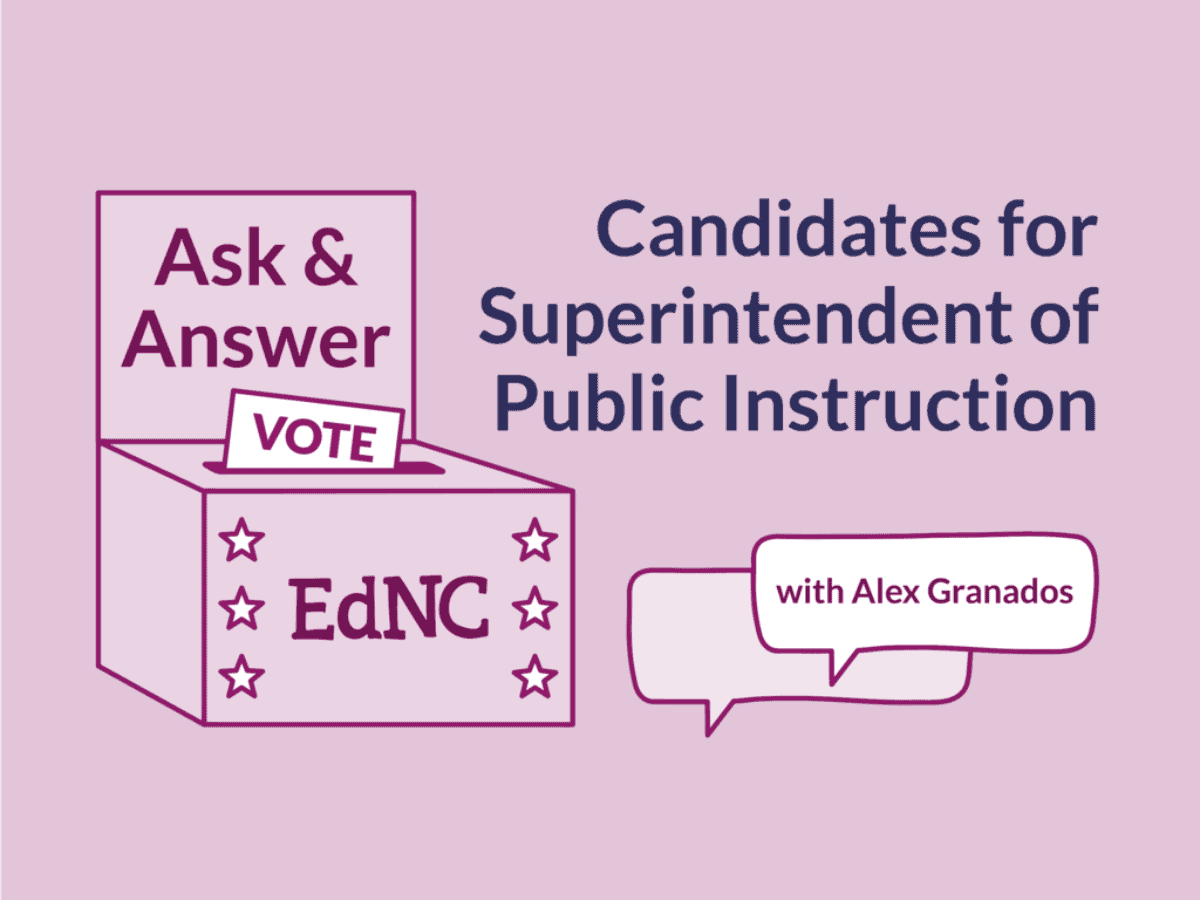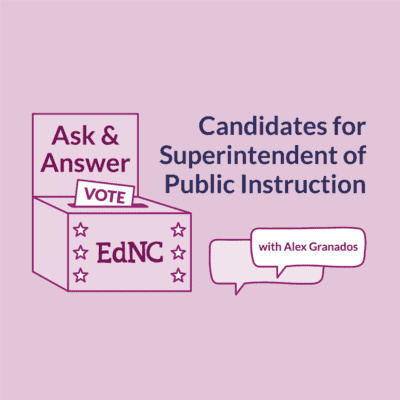

In a recent survey, EducationNC asked teachers what questions they had for the two candidates for state superintendent of public instruction. So far, we have received 129 responses. We winnowed those down to the best five and added three of our own. We are going to ask the two candidates for state superintendent one question a week and publish their responses.
Q: What weaknesses in our educational system were highlighted by COVID-19? How should they be addressed?
Democratic candidate Jen Mangrum
“Life’s ups and downs provide windows of opportunity to determine your values and goals — think of using all the obstacles as stepping stones to build the life you want.” — Marsha Sinetar
On Friday, March 13, I walked into one of the elementary schools where my university students serve as interns and the principal whispered softly in my ear, “When students leave school this afternoon, we don’t know when they’ll come back.” My heart started racing as I looked down the hall at all the children who are school-dependent. I knew they would need their teachers, assistants, counselors, nurses, librarians, cafeteria workers, peers … now more than ever.
So what weaknesses were highlighted by COVID-19? You’ll hear from so many people that it highlighted the digital divide because many students didn’t have access to devices and broadband. I say, look deeper. Access to the internet and iPads is only a symptom of the larger issue. The true weakness highlighted by COVID-19 in our educational system is the profound inequity found between different schools and districts.
For far too long, North Carolinians have lost out by accepting an education system that offers opportunities to some students that it denies to others. Too many of us consider it acceptable that a white girl entering kindergarten in Chapel Hill has substantially different life prospects than a black boy entering kindergarten in Bertie County. While the costs of these inequities are disproportionately borne by those from historically-marginalized communities, they ultimately harm all North Carolinians. We all stand to gain by creating an equitable education system where a child’s background is no longer predictive of their outcomes.
The school closures caused by the COVID-19 pandemic have exacerbated the inequities already inherent in our school system. The impacts of the pandemic (loss of instructional days, diminished instructional quality, an uptick in adverse childhood experiences, and cuts to school budgets) fall disproportionately on our most vulnerable students. As a result, this crisis requires a doubling-down on efforts to eliminate long-standing educational inequities.
So how would I address the highlighted issue of equity in North Carolina’s public education system? Here are just a few examples.
- Redesign our school accountability model in innovative ways that promote equity. Our current model predicts the level of poverty in a school and is punitive. What if we evaluated schools on the degree to which they are diverse or the access to opportunity they give their most vulnerable children?
- Increase the number of magnet schools. Compared to traditional public schools, magnet schools are more likely to be diverse, and studies have shown that all students benefit in these environments. Integrated magnet schools promote higher levels of social cohesion, a reduced likelihood of racial prejudice, and enhanced critical thinking.
- Implement part-time and summer enrichment programs that reach across district lines and bring together diverse communities. Most families need child care after school and in the summer. They seek out excellent summer opportunities for their children, but they can be expensive and hard to find. By offering grants for innovative and creative enrichment opportunities and monitoring their ability to bring diverse communities together, all children benefit from extended learning and experiences beyond what they typically encounter.
- Design and implement community schools. Community schools focus on academic AND non-academic needs of students as well as culturally relevant pedagogy. There are three main components: 1) a strong instructional program, 2) expanded learning opportunities and 3) an infrastructure to support the physical and mental health of children along with social services. Community schools promote the child’s well-being and remove barriers to learning.
Of course, the above is not a comprehensive list. Sustained investments — particularly where needs are greatest — will be required before we reach our goal of creating integrated school communities that can meet all children’s needs, allowing equal opportunities to flourish.
COVID-19 has been deadly and has significantly hurt our state’s economic health. However, it has also highlighted the huge inequities in children’s access and opportunity for a high quality education. My promise to the state of North Carolina is that I will not accept the status quo. I will use my time as superintendent to fight for investments for ALL of our children so that every child can live into their fullest potential.
Republican candidate Catherine Truitt
When I read the question posed by EdNC this week, my first thought was, “How can I respond to this accurately? Forsyth County has one set of needs, Henderson County has another, and Currituck County has yet another.” But after jotting down some thoughts, I realized that there are some serious challenges exposed by the virus that are exactly the same across most of our state.
1. The digital divide. In 2018, North Carolina became the first state in the nation to offer its students robust Wi-Fi in every public K-12 learning space. This was a massive, bipartisan achievement that spanned multiple administrations that I prioritized during my prior role as senior education advisor to Gov. McCrory. Effective digital learning rests on three pillars: reliable internet access, devices, and instruction. If students don’t have devices and broadband at home, they cannot learn remotely — regardless of how ready their teachers are with quality online instruction. The digital divide in North Carolina encompasses two overarching challenges:
- Access and affordability. According to the Department of Public Instruction, there are over 300,000 students without internet access at home, and an estimated 69,000 students lack access to a computer at home. In many cases, the situation is one of affordability. However, we have an amazingly diverse state and some of our rural areas remain underserved by broadband despite a series of public investments hearkening back more than a decade. Solutions include working with the General Assembly and local internet service providers to offer reduced subscription rates in low-income areas as well as partnering with innovative companies offering solutions in rural areas, such as low-orbit satellite service. Public-private partnerships and grants that serve to provide devices to students have worked in several counties throughout the state and could be a model to other districts.
- Inconsistent implementation of the state’s Digital Learning Initiative (NCDLI). Designed at the request of the State Board of Education by the Friday Institute at NC State, the goal of the NCDLI is to create a long-term, collaborative strategy that helps teachers and students benefit from personalized leaning through technology. Inconsistent funding at the state and local levels as well as varying levels of commitment from local leadership meant that some districts were incredibly prepared for remote learning while others had little to offer, creating further achievement gaps between low-income students and their wealthier counterparts. Solutions include equitable funding from the state for districts (including professional development for teachers) without a sufficient tax base as well as securing buy-in from local leaders. We must continue down the path we’ve already started on of leveraging technology to assist — not replace — teachers in customizing education for their students.
2. The school accountability system. Unfortunately, our current system of school accountability tends to incentivize a culture of compliance rather than a culture of learning. End-of-grade (EOG) testing in elementary school often results in “one-and-done” tests, the results of which do not make it in the mail to parents until well into the summer.
These EOG tests are inappropriately long, dreaded by teachers, parents, and students alike, and provide no actionable feedback for most children. Since nearly all fourth graders are promoted to fifth grade, even though two-thirds of them are deemed (by other measures) to not be proficient in reading or math, the EOG tests lack validity. Yet the results of these tests represent 80% of a school’s report card grade, with only 20% of the grade coming from the growth students make throughout the year.
My observation is that when the legislature waived EOG testing for the 2019-20 school year due to COVID-19, there was a collective sigh of relief “heard ‘round the world.” Feeling free from stifling regulations and a misaligned accountability framework, many teachers started teaching in new, innovative ways. Written, personalized feedback became the method of assessment rather than a letter grade. Virtual one-on-one meetings between students and teachers and small group instruction became common as did more meaningful, regular communication with parents through phone check-ins (who were more eager than usual to engage!). And students didn’t stop learning new material in April to prepare for an EOG. Solutions include:
- Thinking differently about how to assess and showcase student growth and achievement with portfolios and a transcript that showcases a student’s skills and competencies upon graduation.
- Creating new statewide assessments that occur throughout the year and are competency-based so that students do not progress until each skill or concept is mastered.
- Revising the school accountability system such that growth and achievement are weighted 50/50.
- Continuing the feedback loops that emerged out of necessity during the school closures such that students and parents are more in tune with academic progress.
3. The importance of equitable funding. In times of crisis like the COVID-19 pandemic, the outstanding qualities of our education leadership at the county level really become apparent. However, no matter how gifted individual superintendents or principals are, they could not manufacture nonexistent resources. While the State Board of Education and the legislature worked on the nuts and bolts of attendance and testing waivers, many local school leaders and teachers focused on the practical realities of the emergency. Some were appropriately engaged by trying to help feed their students, with remote learning a secondary priority. High-poverty districts, already suffering an achievement gap, were more likely to experience a prolonged disruption in learning due to the higher number of students without internet access and devices. This, in turn, likely expanded the achievement gap even further.
The legislature adjusts funding so that small and low wealth counties receive additional money. There is also a different funding formula to ensure students with special needs receive more funding than the basic per pupil expenditure. However, data show that these adjustments are not enough to ensure that all districts provide a sound, basic education as required by the State Constitution. Twenty four percent of school funding comes from the local level but because this dollar amount is tied to a county’s tax base, the number varies from $450 per student to $6,500 per student.
As the state looks to enact the recommendations from the WestEd Report, we will have an opportunity to close this funding gap by considering alternative funding models ensuring equity of resources. Also, increasing funding flexibility at the local level will ensure resources are allocated where they are needed most. There are no one-size-fits all solutions in education and district leadership and teachers are the best people to determine students’ needs.
The three challenges outlined here are not insurmountable. They will require a growth mindset from educators, stakeholders, leaders, and parents that allows for innovation and new ways of doing things. If we are to emerge from this crisis better than before, we must be willing to prioritize digital inclusion, relevant assessment policies, and the provision of equity of resources in our schools. The consequences of not doing so will fail yet another generation of students.


